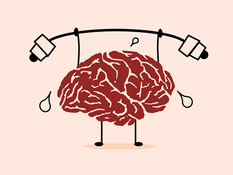Can Physical Exercise Combat Alzheimer’s Disease?
Alzheimer’s disease (AD) is a devastating disorder, and its incidence is only growing. Alzheimer's is a type of dementia or neurodegenerative illness. It affects primarily elderly people as age is one of its most significant risk factors among other things such as physical activity, which is discussed in more detail later on, obesity, hypertension, and social isolation. With much of the planet’s population growing older and living longer due to advances in health care, millions of more individuals will be susceptible to diseases such as Alzheimer’s. With this in mind, many people are keen to find ways to avoid this bleak path. One 2020 review article focused on increased physical activity as a possible solution and compiled many of the novel and proven studies linking these together.
Before presenting the evidence, it is important to establish background knowledge on the causes of Alzheimer’s disease. Alzheimer’s is likely caused through by the accumulation of both beta-amyloid proteins and tau proteins. The build up of these proteins creates tangles and plaques within the brain that trigger responses from the brain that leads to inflammation, break down of neurons, cognitive decline, and further development of these proteins. This vicious cycle leads to a more severe progression of the disease and accounts for continual memory loss commonly observed in AD patients.
Before presenting the evidence, it is important to establish background knowledge on the causes of Alzheimer’s disease. Alzheimer’s is likely caused through by the accumulation of both beta-amyloid proteins and tau proteins. The build up of these proteins creates tangles and plaques within the brain that trigger responses from the brain that leads to inflammation, break down of neurons, cognitive decline, and further development of these proteins. This vicious cycle leads to a more severe progression of the disease and accounts for continual memory loss commonly observed in AD patients.
Image Source: geralt
A pivotal 2011 paper that set the stage for future investigation found that a year of following a strict, regimented exercise plan increased brain size in the hippocampus region (responsible for memory) in elderly people. Other studies show even half a year of this regimented exercise plan can increase white and gray matter, different areas of the brain, in older patients. Along with short-term measures, long-term exercise plans have been noted to counter some neurological and physical decline seen with increases in age.
In a review of 24 studies on resistance or weight training in elderly people, the researchers concluded that a primarily resistance-based training program was effective in improving cognitive function. Nonetheless, more research on this specific topic still needs to be done. Another analysis with 16 studies showed that among 160,000 individuals, 45% of them showed that through regimented exercise protocols, participants had a far less severe risk in developing AD. Increased physical activity is also associated with a reduction of the negative effects of beta-amyloid protein (a protein involved in causing AD). The scientific reasoning behind the powerful effects of exercise against battling AD is due to alterations in the brain at many levels that all contribute to improved memory and cognitive function. Specifically to Alzheimer’s, the increased blood flow during exercise can also help decrease beta-amyloid accumulation and tau protein tangles.
Although the topics mentioned above still need to be researched in greater depth, the sheer amount of positive gains of regular exercise extend beyond delaying the progression of AD and are a crucial part of maintaining proper health as the human population ages.
In a review of 24 studies on resistance or weight training in elderly people, the researchers concluded that a primarily resistance-based training program was effective in improving cognitive function. Nonetheless, more research on this specific topic still needs to be done. Another analysis with 16 studies showed that among 160,000 individuals, 45% of them showed that through regimented exercise protocols, participants had a far less severe risk in developing AD. Increased physical activity is also associated with a reduction of the negative effects of beta-amyloid protein (a protein involved in causing AD). The scientific reasoning behind the powerful effects of exercise against battling AD is due to alterations in the brain at many levels that all contribute to improved memory and cognitive function. Specifically to Alzheimer’s, the increased blood flow during exercise can also help decrease beta-amyloid accumulation and tau protein tangles.
Although the topics mentioned above still need to be researched in greater depth, the sheer amount of positive gains of regular exercise extend beyond delaying the progression of AD and are a crucial part of maintaining proper health as the human population ages.
Featured Image Source: Free-Photos
RELATED ARTICLES
|
Vertical Divider
|
Vertical Divider
|
Vertical Divider
|






